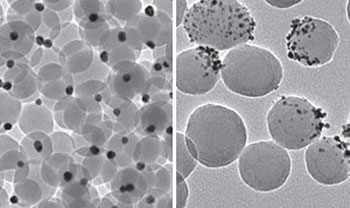| May 11, 2011 |
Innovative approach allows 'Janus snowmen' to be synthesized at the interface between two immiscible liquids
|
|
(Nanowerk News) Organic solutions dispersed with charged nanoparticles offer exciting opportunities for applications ranging from drug delivery to the optical displays. Chaobin He and co-workers at the A*STAR Institute of Materials Research and Engineering have now prepared an organic solution of 'Janus' nanoparticles having both negatively and positively charged regions ("PEG-POSS Assisted facile preparation of amphiphilic gold nanoparticles and interface formation of Janus nanoparticles").
|
|
Janus particles are hybrid particles with two chemically distinct regions. They can be made in several ways, such as by trapping the particles in a solid medium that masks one side of the particle during chemical processing, or by joining two particles with distinct chemical properties together. He and his co-workers used the latter approach in combination with liquid–liquid interface reactions to prepare snowman-like dipolar nanoparticles, in all shapes and sizes.
|
 |
| Transmission electron microscopy images of snowman-like Janus particles consisting of a large silica sphere and multiple small gold nanoparticles. Particles are ~50 nanometers in diameter. (©2011 RSC)
|
|
The researchers first prepared negatively charged gold nanoparticles in an organic solution. They synthesized citrate-coated gold nanoparticles, and then reacted the gold nanoparticles with a polymer known as PEG-POSS. The resulting PEG-POSS-coated gold nanoparticles were amphiphilic—having a polar water-soluble group and a nonpolar water-insoluble part—and could mix well with organic solvents. They then formed their dipolar snowman-like Janus nanoparticles (pictured) by mixing the organic solution containing negatively charged gold nanoparticles with an aqueous solution containing positively charged silica nanoparticles.
|
|
In contrast to traditional syntheses of coated nanoparticles, which rely on ligand exchange, this novel method allows the nanoparticles to retain their negative charge. The transfer of positively charged nanoparticles, nanorods and neutral silica nanoparticles into organic solutions is also possible.
|
|
In the synthesis, because PEG-POSS is bound to the gold nanoparticles by hydrogen bonds and non-covalent interactions, these ligands are easily lost. This is an important feature that allows the snowman's head to be 'glued' onto the body. When the aqueous solution of silica particles with positively charged surface was poured carefully onto the top of the organic solution of PEG-POSS-coated gold nanoparticles, a red layer of Janus particles was formed at the interface between the two solutions. Removing the red layer with a pipette encouraged the formation of more Janus particles. These Janus particles are unique because they are composed of one large positively charged silica particle and several small negatively charged gold nanoparticles.
|
|
The researchers are now planning to create an optical display device from their dipolar Janus particles. "There are opposing charges in a single particle, so once a direct current is applied, the particle can flip. We therefore hope to achieve a switchable element as a pixel in an optical display," says He.
|

